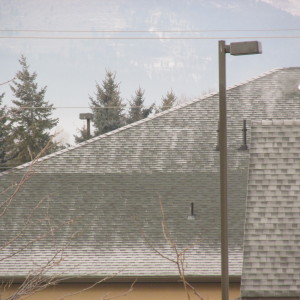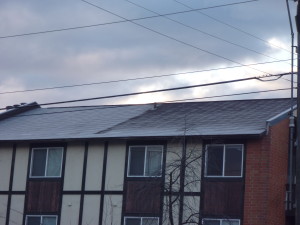In the Northerly climates, we can tell a lot about the insulation we have in our attics by looking at our roof after a snowfall or frost, without even having to get into the attic! Simply observing your roof can tell you a lot about the health of your insulation. A good experiment is to observe your roof and your neighbor’s roof. You’ll notice after a snow fall or frost (if the temperature is above freezing or the sun is directly shining on it – assuming you’ve enough insulation) that the “blanket of snow” is smooth across the entire roof. As we know with frost, the sun can burn it off much quicker so the time frame to do your inspection is much shorter than that with snow, especially if several inches have fallen. For instance if you have a building that is uninsulated, the roof/attic would usually be the same temperature as the building and with heat rising, the heat from the structure, would melt the snow or frost faster. For example if you have a spot near the eave that constantly melts but there’s snow above and below, you have insulation/ventilation issues. Having bad or no insulation, you are paying to heat the outdoors. Have you ever seen icicles hanging down off the front eave? This is caused by a warm attic that melts the snow layer from the bottom. That water runs down the warm roof until it hits the cold area at the edge where it freezes and backs up under the shingles. When that happens you can get water in the attic and the house, and, as some of us have seen, causes a lot of damage. All things that we want to avoid. An attic that has good insulation will give you most of the indicators you need, just by looking at your roof. That being said, it can really pay to have good insulation. Good insulation can reduce noise, ice dams, mold issues, insect or dust issues, and cut back on your utility bills every month. For all of your insulation or roofing questions and concerns, please give us a call at Jared Langley Roofing and Remodel today. Thank You for your time and future business, Jared Langley Roofing and Remodel /406-251-6363 / 406-541-ROOF – Serving Montana and Idaho
 Please, first notice the frost in some areas and the lack in other areas. In this
Please, first notice the frost in some areas and the lack in other areas. In this
particular circumstance, we’ve got the top half of the roof which is insulated
more adequately than the bottom portion. We do see this at times, where the
insulation has been moved, pushed back, or has simply settled. Please notice
the vertical lines on this particular roof that have frost (lower half). These are the trusses,
or over-framing under the roof deck. The portion you can see between the
lines is melted. This is the first indicator that we should be adding more
insulation in the attic. NOTE: If this particular attic had the proper amount of
insulation, we’d be looking at a smooth layer of frost over the entire roof.
 This depiction of the “Frost Test” is even more visible. This structure has the same roof line, but as you can see,
This depiction of the “Frost Test” is even more visible. This structure has the same roof line, but as you can see,
the frost on the right section has melted off, leaving the telltale marks of the trusses on the shingles (vertical white lines). In this
particular instance, the right side has inadquate insulation, while the left side has enough insulation to keep the heat
from inside the dwelling unit, from rising up and getting through the insulation therefore melting the frost off of the shingles above.
There are multiple things that can affect this type of condition, but the first “culprit” is usually a lack of insulation.
Another factor which can cause this type of “frost melt” would be that, the bath fans are not vented to the
exterior of the structure, but into the attic. Additionally, and keeping the previous in mind, you may have an
operational bath fan that is designed and piped/vented to the exterior of the structure, not into the attic, but still have this
scenario. If you do have a properly vented bath fan, range hood, etc., you will see the vent on the top of the roof,
or on the side wall of your home. If possible, we recommend the roof style exhaust vent in this climate.
There are circumstances which make it almost impossible, or financially non-viable to vent through the roof and
contractors will have to vent out a side-wall of the home or building. Please bear in mind that heat rises and in a
colder climate, with the heat rising, you’ll see it rise up the wall and freeze on the bottom of the soffit, or eave areas with some side wall vents.
Let’s assume the bath fan or hood vent was put in and is exhausted through the roof to the outside. When possible
and safe, have someone inside the home turn the bath fan on while you’re watching the hood vent from outside your home.
If the switch is turned on from the inside and it’s working property, you should see the flapper of the hood vent open when on and shut when
the fan has been turned off. It’s typical when we have huge temperature swings (ie, the
house is 70 degrees F inside and it’s 0 degrees F, or colder, outside), to get a condensation drip through the bath
fan inside the home when you turn it on, especially if it’s a bathroom you don’t use very often. It’s also a possibility if the
temperatures drop and stays low for an extended period of time, that the flapper on the hood vent will freeze shut, or open.
If this occurs, you may notice some water, inside the structure, below the fan. NOTE: We suggest calling us for all inspections, but more so for the next
type of inspection due to safety reasons, however, if you’re a DIY’r, you can remove the scuttle, or attic access
hatch, and look into your attic when the temperature is sub freezing outside. If you see normal, non-frost covered
plywood (from inside the attic) and the absence of mold, you’re probably ok………. providing the frost or snow is
covering your roof with a smooth “blanket” look.
